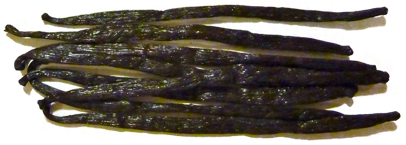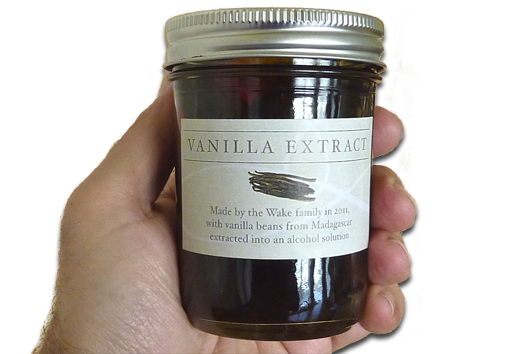

We all know that the primary food groups are sugar, fat, and salt, and these great building blocks of happiness are indeed something to appreciate. But let’s not forget the simple joy of vanilla flavor! Awhile back your faithful webmaster was talking to his yoga instructor about vanilla extract. Her son wanted to become a chef, and their family was curious about how I’d made some vanilla extract that I’d given her for Christmas. I’m no expert on the subject, but after sharing with her what I’ve gleaned about vanilla extract making from poking around the Internet and from experimenting, I figured I’d put up this web page for broader consumption.
First, we must confront a particular horror. Extracts are made from soaking an item in ethyl alcohol—in an ethanol solution—to extract the flavor of the item into the solution. Every extract you see in the store will have alcohol as its primary ingredient, be it almond extract or mint extract or vanilla extract or whatever. If you’re an off-the-deep-end teetotaler, then you’d best stop reading and move on. Stick to imitation vanilla extract, which doesn’t have alcohol in it or any vanilla either (but is made from wood pulp and odder things). In fact, stop baking bread also, because you’re basically making alcohol in your bread dough when you let the yeast do its thing. Pizza and burgers and many soft drinks are right out. But I digress. So where do you get the ethanol for real vanilla extract? It’s easiest to use vodka. In Utah, go down to the state liquor store. Vodka is straight ethanol without flavors like hops or grapes or whatever, and the concentration is about right for vanilla extract. There is such a thing as flavored vodka, but for extracts almost everyone uses just regular vodka. Some people think they can taste alcohol when vanilla extract is used uncooked in something like ice cream, but my taste isn’t that sophisticated. I don’t know anything about vodka, but I would guess that top shelf vodka is likely a complete waste of money, and bottom shelf vodka is probably down there for a reason. The cheapest vodka that comes in glass bottles instead of plastic is probably a good compromise, especially if it’s on sale. If you’re LDS, this shopping trip is going to be a really interesting experience. Maybe you could wear a disguise, and take it off quickly at the cash register when they ID you for age.
Vanilla beans are available on Amazon.com and from a few other places. Always buy vanilla beans in bulk. Never, ever buy them by ones or twos in a little jar from the spice section at the grocery store, because the individual beans at grocery stores are very exorbitantly priced. Madagascar/Bourbon beans have the flavor that most people are used to. Tahitian beans are supposedly a bit more floral or fruity, although I can’t tell a lot of difference. Mexican beans are supposed to be pretty good, but they are more expensive and harder to find, and I’ve never used them (premade Mexican vanilla extract once got a bad rap for some of it being made with a different kind of possibly dangerous bean, but if you’re making vanilla extract from scratch with beans you’re handling then that’s not an issue, because the bad type of beans look like deer poop and no one would confuse them with long, thin real vanilla beans whether from Mexico or elsewhere). You can always mix different types of vanilla beans together: Madagascar and Tahitian, for example. Shop around online, because deals change all the time. You should be able to find beans for in the thirty-some dollars per half pound range, on a good day; less for a smaller amount, of course, although the per bean price increases with smaller bulk amounts. Grade B/extract grade vanilla beans cost less, and for extract use they work fine, some people think even better. [Autumn of 2016 edit: it looks like the vanilla bean suppliers are now charging over $100 for a half a pound of beans, which is well over twice what beans usually cost, because of issues in Madagascar. Spring of 2017 edit: now prices are even higher, about five times normal, and far out of the range of affordability; also, rumor is that low quality beans are being mixed in with decent beans by people trying to cash in on high prices, and that new rapid curing methods used by speculators who do not like traditional hand curing methods are turning some good beans into poorly flavored beans.]
There are a lot of different extract making directions online, and some of them seem awfully watered down, probably because people are trying to save money by skimping on beans. As near as I can tell, the most common and reasonable ratio of beans to alcohol is just under one pound of beans per one gallon of alcohol. Or, about one ounce of beans (about eight beans, probably) per cup of alcohol. And therein lies a problem. Beans are sold by the pound, but vodka is sold by milliliters or liters, not by quarts or gallons. So you have to do some conversion, because you can’t go ask for a gallon of vodka. One gallon equals 3.785 liters. A half gallon equals 1.9 liters. Speaking of math, there’s no set way to tell how many beans are in a pound. If they’re grade B/extract grade beans, there would be more of them, and if they’re puffy and pretty grade A beans, there would probably be fewer. I think I had somewhere around seventy beans in the last half pound I bought, but it’ll vary from order to order. Ultimately, I hear that bakers like “double fold” vanilla extract, which is stronger than normal extract, so I would worry more about having too few beans than too many. You will have to figure out how much extract you want to make, and then do the math and buy your supplies accordingly. A half pound of beans and two liters of vodka combine to make a decent amount of vanilla extract for personal use and giving as gifts, or you could reserve a few of the beans for other culinary uses, and use the bulk of them with 1750 ml of vodka (I usually divide a half pound of beans between a bunch of half pint mason jars, and two liters of vodka will fill about a dozen jars when the beans are already in them, and 1750 ml will fill about ten jars when the beans are already in them).
Some people say to slice lengthwise into the beans and scrape the beans before putting them in the alcohol, so the little black “seeds” float around and create flavor faster. Some say just to slice the beans lengthwise and the alcohol will access all the flavor in the bean. Some say just to chop them into sections without slicing down them. The latter idea doesn’t seem right to me. I usually slice them but don’t necessarily scrape the insides out (if I’m making crème brûlée or vanilla ice cream, I slice and scrape out a bean to free up all the little black speckles for visual effect). Once you get the beans into the alcohol solution, shake the container or containers well, then leave them in a cool, dark place and shake them once a day for a couple of months; don’t worry if you miss a day here or there. I don’t actually know how important cool and dark part is, but it’s probably a good idea. Shake them and give them their time, and soon enough you’ll have really good vanilla extract. Cheaper than store bought vanilla extract, not terribly much more expensive than imitation vanilla extract, and better than either. You can reuse the beans, but I haven’t seen anything credible that says how many times you can do that or how much extra time you’ll need to soak them, so just experiment. Some people like to put a used bean in their sugar container to flavor the sugar.
Be careful who you give this to as a gift. A co-worker’s husband developed such an affinity for the flavor of vanilla that he took to drinking extract straight. She was appalled when she caught him. I was, too, because vanilla extract tastes bad straight. It isn’t the main course, it’s a flavor!
